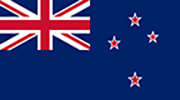NZ3
The New Zealand flag is the symbol of the realm, government and people of New Zealand. Its royal blue background is derived from the ensign of the Blue Squadron of the Royal Navy. The stars of the Southern Cross emphasise this country's location in the South Pacific Ocean. The Union Jack in the first quarter recognises New Zealand's historical origins as a British colony and dominion.
Flag of New Zealand

NZ4
Kiwis are flightless birds endemic to New Zealand. Approximately the size of a domestic chicken, kiwi are by far the smallest living ratites. DNA sequence comparisons have yielded the surprising conclusion that kiwi are much more closely related to the extinct Malagasy elephant birds than to the moa with which they shared New Zealand. There are five recognised species, four of which are currently listed as vulnerable, and one of which is near-threatened. All species have been negatively affected by historic deforestation but currently the remaining large areas of their forest habitat are well protected in reserves and national parks. At present, the greatest threat to their survival is predation by invasive mammalian predators. The kiwi's egg is one of the largest in proportion to body size (up to 20% of the female's weight) of any species of bird in the world. Other unique adaptations of kiwi, such as their hairlike feathers, short and stout legs, and using their nostrils at the end of their long beak to detect prey before they ever see it, have helped the bird to become internationally well-known.
DNA sequence comparisons have yielded the surprising conclusion that kiwi are much more closely related to the extinct Malagasy elephant birds than to the moa with which they shared New Zealand. There are five recognised species, four of which are currently listed as vulnerable, and one of which is near-threatened. All species have been negatively affected by historic deforestation but currently the remaining large areas of their forest habitat are well protected in reserves and national parks. At present, the greatest threat to their survival is predation by invasive mammalian predators. The kiwi's egg is one of the largest in proportion to body size (up to 20% of the female's weight) of any species of bird in the world. Other unique adaptations of kiwi, such as their hairlike feathers, short and stout legs, and using their nostrils at the end of their long beak to detect prey before they ever see it, have helped the bird to become internationally well-known.
 The silver fern itself is a quasi-national emblem, being used for various official symbols, including the coat of arms of New Zealand and the New Zealand one dollar coin. A number of New Zealand sports teams, such as the cricket team, the Silver Ferns and the All Blacks, use similar silver fern flags as part of their official merchandise. The All Whites association football team use a white background and a black version of the fern.
The silver fern itself is a quasi-national emblem, being used for various official symbols, including the coat of arms of New Zealand and the New Zealand one dollar coin. A number of New Zealand sports teams, such as the cricket team, the Silver Ferns and the All Blacks, use similar silver fern flags as part of their official merchandise. The All Whites association football team use a white background and a black version of the fern.